Yingchen Yu
GUI-Rise: Structured Reasoning and History Summarization for GUI Navigation
Oct 31, 2025Abstract:While Multimodal Large Language Models (MLLMs) have advanced GUI navigation agents, current approaches face limitations in cross-domain generalization and effective history utilization. We present a reasoning-enhanced framework that systematically integrates structured reasoning, action prediction, and history summarization. The structured reasoning component generates coherent Chain-of-Thought analyses combining progress estimation and decision reasoning, which inform both immediate action predictions and compact history summaries for future steps. Based on this framework, we train a GUI agent, \textbf{GUI-Rise}, through supervised fine-tuning on pseudo-labeled trajectories and reinforcement learning with Group Relative Policy Optimization (GRPO). This framework employs specialized rewards, including a history-aware objective, directly linking summary quality to subsequent action performance. Comprehensive evaluations on standard benchmarks demonstrate state-of-the-art results under identical training data conditions, with particularly strong performance in out-of-domain scenarios. These findings validate our framework's ability to maintain robust reasoning and generalization across diverse GUI navigation tasks. Code is available at https://leon022.github.io/GUI-Rise.
Debiasing Text-to-Image Diffusion Models
Feb 22, 2024Abstract:Learning-based Text-to-Image (TTI) models like Stable Diffusion have revolutionized the way visual content is generated in various domains. However, recent research has shown that nonnegligible social bias exists in current state-of-the-art TTI systems, which raises important concerns. In this work, we target resolving the social bias in TTI diffusion models. We begin by formalizing the problem setting and use the text descriptions of bias groups to establish an unsafe direction for guiding the diffusion process. Next, we simplify the problem into a weight optimization problem and attempt a Reinforcement solver, Policy Gradient, which shows sub-optimal performance with slow convergence. Further, to overcome limitations, we propose an iterative distribution alignment (IDA) method. Despite its simplicity, we show that IDA shows efficiency and fast convergence in resolving the social bias in TTI diffusion models. Our code will be released.
Pose-Free Neural Radiance Fields via Implicit Pose Regularization
Aug 29, 2023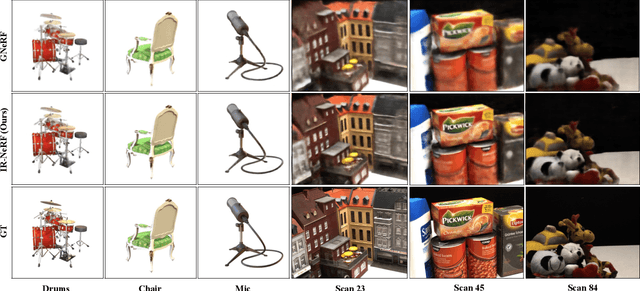
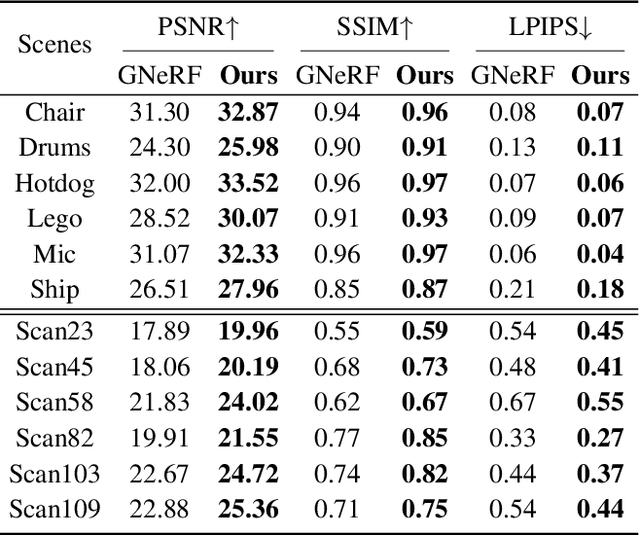
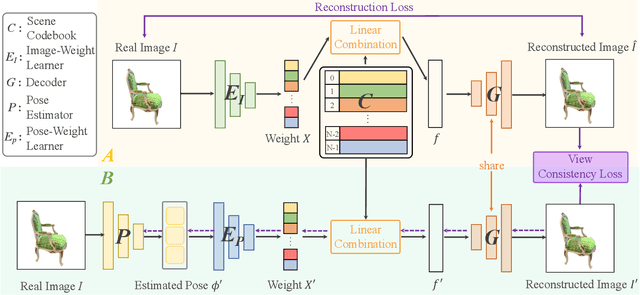

Abstract:Pose-free neural radiance fields (NeRF) aim to train NeRF with unposed multi-view images and it has achieved very impressive success in recent years. Most existing works share the pipeline of training a coarse pose estimator with rendered images at first, followed by a joint optimization of estimated poses and neural radiance field. However, as the pose estimator is trained with only rendered images, the pose estimation is usually biased or inaccurate for real images due to the domain gap between real images and rendered images, leading to poor robustness for the pose estimation of real images and further local minima in joint optimization. We design IR-NeRF, an innovative pose-free NeRF that introduces implicit pose regularization to refine pose estimator with unposed real images and improve the robustness of the pose estimation for real images. With a collection of 2D images of a specific scene, IR-NeRF constructs a scene codebook that stores scene features and captures the scene-specific pose distribution implicitly as priors. Thus, the robustness of pose estimation can be promoted with the scene priors according to the rationale that a 2D real image can be well reconstructed from the scene codebook only when its estimated pose lies within the pose distribution. Extensive experiments show that IR-NeRF achieves superior novel view synthesis and outperforms the state-of-the-art consistently across multiple synthetic and real datasets.
WaveNeRF: Wavelet-based Generalizable Neural Radiance Fields
Aug 09, 2023

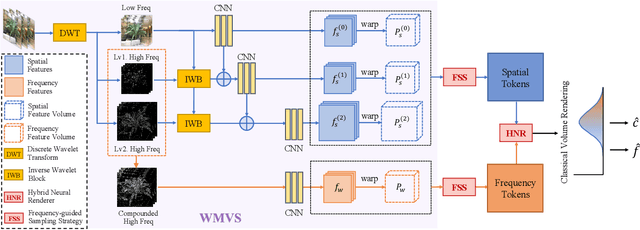

Abstract:Neural Radiance Field (NeRF) has shown impressive performance in novel view synthesis via implicit scene representation. However, it usually suffers from poor scalability as requiring densely sampled images for each new scene. Several studies have attempted to mitigate this problem by integrating Multi-View Stereo (MVS) technique into NeRF while they still entail a cumbersome fine-tuning process for new scenes. Notably, the rendering quality will drop severely without this fine-tuning process and the errors mainly appear around the high-frequency features. In the light of this observation, we design WaveNeRF, which integrates wavelet frequency decomposition into MVS and NeRF to achieve generalizable yet high-quality synthesis without any per-scene optimization. To preserve high-frequency information when generating 3D feature volumes, WaveNeRF builds Multi-View Stereo in the Wavelet domain by integrating the discrete wavelet transform into the classical cascade MVS, which disentangles high-frequency information explicitly. With that, disentangled frequency features can be injected into classic NeRF via a novel hybrid neural renderer to yield faithful high-frequency details, and an intuitive frequency-guided sampling strategy can be designed to suppress artifacts around high-frequency regions. Extensive experiments over three widely studied benchmarks show that WaveNeRF achieves superior generalizable radiance field modeling when only given three images as input.
3D Open-vocabulary Segmentation with Foundation Models
May 24, 2023



Abstract:Open-vocabulary segmentation of 3D scenes is a fundamental function of human perception and thus a crucial objective in computer vision research. However, this task is heavily impeded by the lack of large-scale and diverse 3D open-vocabulary segmentation datasets for training robust and generalizable models. Distilling knowledge from pre-trained 2D open-vocabulary segmentation models helps but it compromises the open-vocabulary feature significantly as the 2D models are mostly finetuned with close-vocabulary datasets. We tackle the challenges in 3D open-vocabulary segmentation by exploiting the open-vocabulary multimodal knowledge and object reasoning capability of pre-trained foundation models CLIP and DINO, without necessitating any fine-tuning. Specifically, we distill open-vocabulary visual and textual knowledge from CLIP into a neural radiance field (NeRF) which effectively lifts 2D features into view-consistent 3D segmentation. Furthermore, we introduce the Relevancy-Distribution Alignment loss and Feature-Distribution Alignment loss to respectively mitigate the ambiguities of CLIP features and distill precise object boundaries from DINO features, eliminating the need for segmentation annotations during training. Extensive experiments show that our method even outperforms fully supervised models trained with segmentation annotations, suggesting that 3D open-vocabulary segmentation can be effectively learned from 2D images and text-image pairs.
POCE: Pose-Controllable Expression Editing
Apr 18, 2023
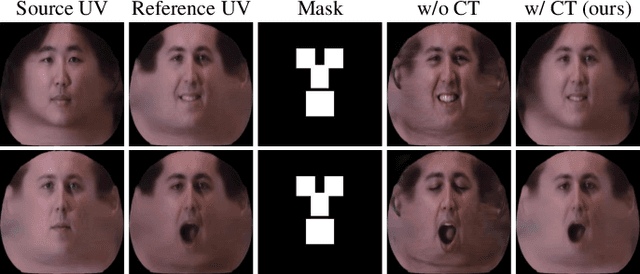


Abstract:Facial expression editing has attracted increasing attention with the advance of deep neural networks in recent years. However, most existing methods suffer from compromised editing fidelity and limited usability as they either ignore pose variations (unrealistic editing) or require paired training data (not easy to collect) for pose controls. This paper presents POCE, an innovative pose-controllable expression editing network that can generate realistic facial expressions and head poses simultaneously with just unpaired training images. POCE achieves the more accessible and realistic pose-controllable expression editing by mapping face images into UV space, where facial expressions and head poses can be disentangled and edited separately. POCE has two novel designs. The first is self-supervised UV completion that allows to complete UV maps sampled under different head poses, which often suffer from self-occlusions and missing facial texture. The second is weakly-supervised UV editing that allows to generate new facial expressions with minimal modification of facial identity, where the synthesized expression could be controlled by either an expression label or directly transplanted from a reference UV map via feature transfer. Extensive experiments show that POCE can learn from unpaired face images effectively, and the learned model can generate realistic and high-fidelity facial expressions under various new poses.
Audio-Driven Talking Face Generation with Diverse yet Realistic Facial Animations
Apr 18, 2023



Abstract:Audio-driven talking face generation, which aims to synthesize talking faces with realistic facial animations (including accurate lip movements, vivid facial expression details and natural head poses) corresponding to the audio, has achieved rapid progress in recent years. However, most existing work focuses on generating lip movements only without handling the closely correlated facial expressions, which degrades the realism of the generated faces greatly. This paper presents DIRFA, a novel method that can generate talking faces with diverse yet realistic facial animations from the same driving audio. To accommodate fair variation of plausible facial animations for the same audio, we design a transformer-based probabilistic mapping network that can model the variational facial animation distribution conditioned upon the input audio and autoregressively convert the audio signals into a facial animation sequence. In addition, we introduce a temporally-biased mask into the mapping network, which allows to model the temporal dependency of facial animations and produce temporally smooth facial animation sequence. With the generated facial animation sequence and a source image, photo-realistic talking faces can be synthesized with a generic generation network. Extensive experiments show that DIRFA can generate talking faces with realistic facial animations effectively.
KD-DLGAN: Data Limited Image Generation via Knowledge Distillation
Mar 30, 2023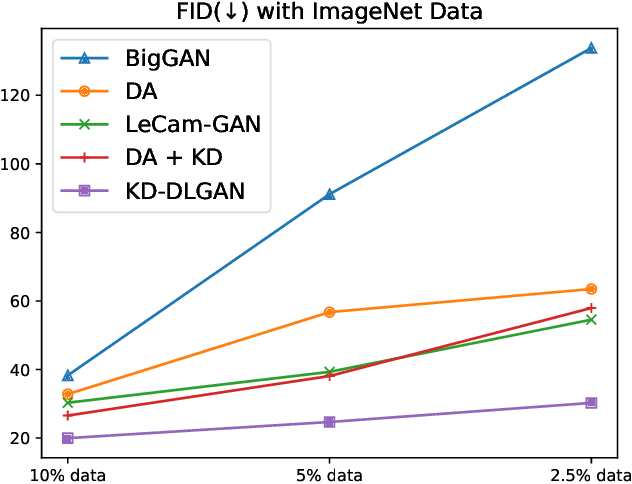
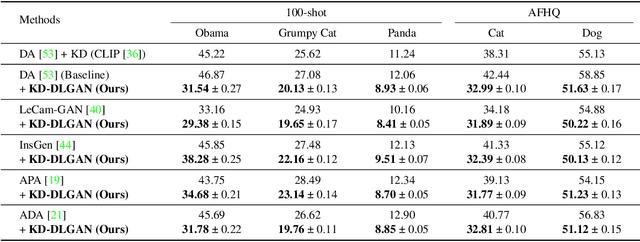
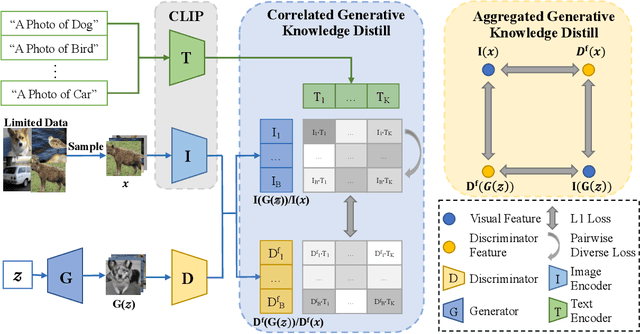
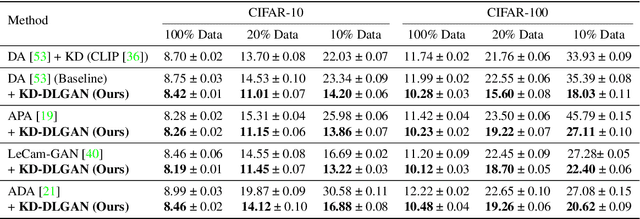
Abstract:Generative Adversarial Networks (GANs) rely heavily on large-scale training data for training high-quality image generation models. With limited training data, the GAN discriminator often suffers from severe overfitting which directly leads to degraded generation especially in generation diversity. Inspired by the recent advances in knowledge distillation (KD), we propose KD-DLGAN, a knowledge-distillation based generation framework that introduces pre-trained vision-language models for training effective data-limited generation models. KD-DLGAN consists of two innovative designs. The first is aggregated generative KD that mitigates the discriminator overfitting by challenging the discriminator with harder learning tasks and distilling more generalizable knowledge from the pre-trained models. The second is correlated generative KD that improves the generation diversity by distilling and preserving the diverse image-text correlation within the pre-trained models. Extensive experiments over multiple benchmarks show that KD-DLGAN achieves superior image generation with limited training data. In addition, KD-DLGAN complements the state-of-the-art with consistent and substantial performance gains.
StyleRF: Zero-shot 3D Style Transfer of Neural Radiance Fields
Mar 24, 2023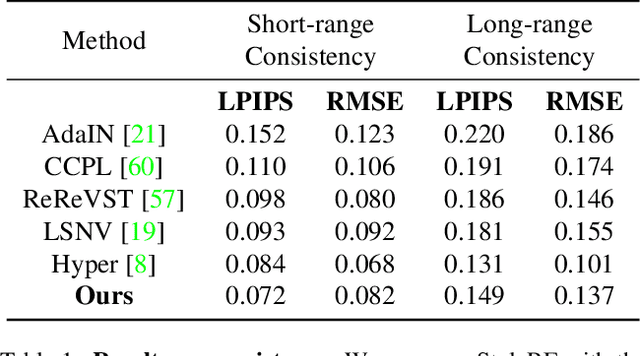

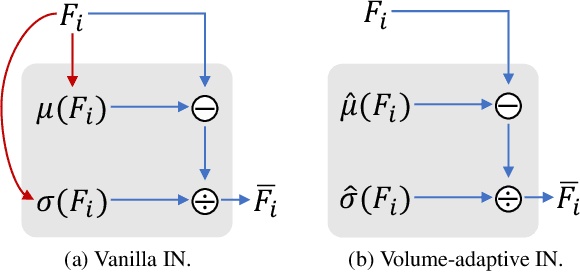
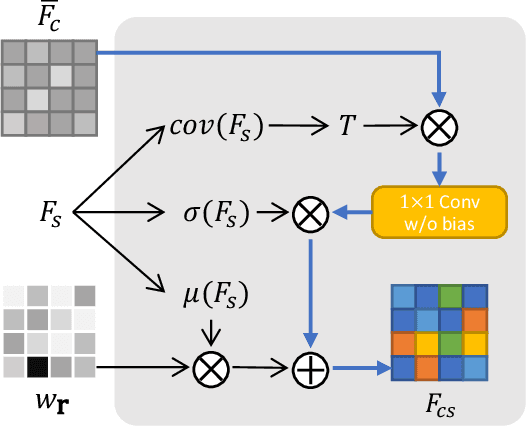
Abstract:3D style transfer aims to render stylized novel views of a 3D scene with multi-view consistency. However, most existing work suffers from a three-way dilemma over accurate geometry reconstruction, high-quality stylization, and being generalizable to arbitrary new styles. We propose StyleRF (Style Radiance Fields), an innovative 3D style transfer technique that resolves the three-way dilemma by performing style transformation within the feature space of a radiance field. StyleRF employs an explicit grid of high-level features to represent 3D scenes, with which high-fidelity geometry can be reliably restored via volume rendering. In addition, it transforms the grid features according to the reference style which directly leads to high-quality zero-shot style transfer. StyleRF consists of two innovative designs. The first is sampling-invariant content transformation that makes the transformation invariant to the holistic statistics of the sampled 3D points and accordingly ensures multi-view consistency. The second is deferred style transformation of 2D feature maps which is equivalent to the transformation of 3D points but greatly reduces memory footprint without degrading multi-view consistency. Extensive experiments show that StyleRF achieves superior 3D stylization quality with precise geometry reconstruction and it can generalize to various new styles in a zero-shot manner.
Towards Efficient Use of Multi-Scale Features in Transformer-Based Object Detectors
Aug 24, 2022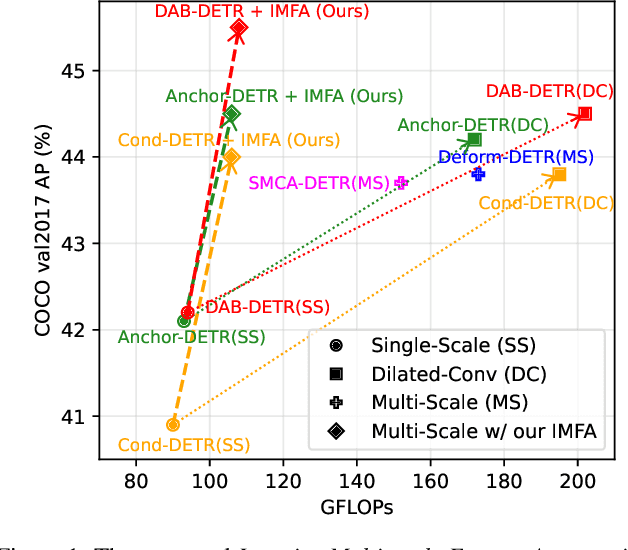
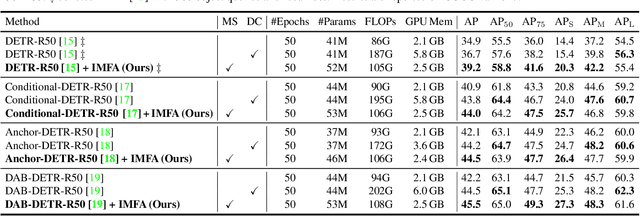
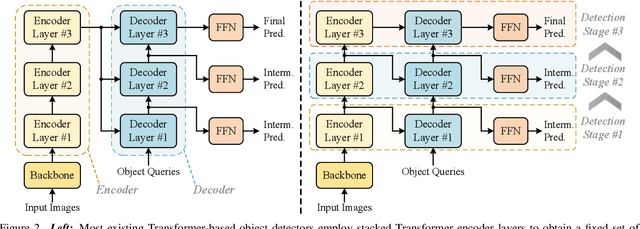
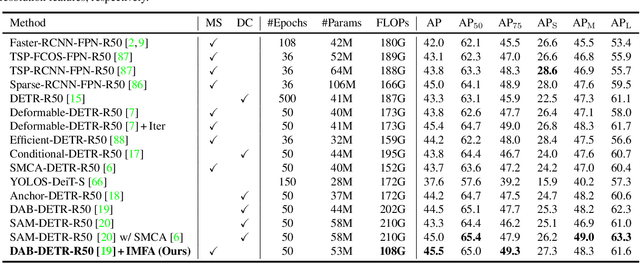
Abstract:Multi-scale features have been proven highly effective for object detection, and most ConvNet-based object detectors adopt Feature Pyramid Network (FPN) as a basic component for exploiting multi-scale features. However, for the recently proposed Transformer-based object detectors, directly incorporating multi-scale features leads to prohibitive computational overhead due to the high complexity of the attention mechanism for processing high-resolution features. This paper presents Iterative Multi-scale Feature Aggregation (IMFA) -- a generic paradigm that enables the efficient use of multi-scale features in Transformer-based object detectors. The core idea is to exploit sparse multi-scale features from just a few crucial locations, and it is achieved with two novel designs. First, IMFA rearranges the Transformer encoder-decoder pipeline so that the encoded features can be iteratively updated based on the detection predictions. Second, IMFA sparsely samples scale-adaptive features for refined detection from just a few keypoint locations under the guidance of prior detection predictions. As a result, the sampled multi-scale features are sparse yet still highly beneficial for object detection. Extensive experiments show that the proposed IMFA boosts the performance of multiple Transformer-based object detectors significantly yet with slight computational overhead. Project page: https://github.com/ZhangGongjie/IMFA.
 Add to Chrome
Add to Chrome Add to Firefox
Add to Firefox Add to Edge
Add to Edge